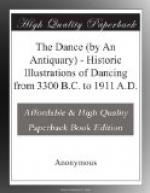Before concluding it is almost imperative to say something about the naked foot dancers, followers of Isidora Duncan. Some critics and a certain public have welcomed them; but is it not “sham antique”? It does not remind one of the really classic. Moreover, the naked foot should be of antique beauty, which in most of these cases it is not. Advertisements tell us that these dance are interpretations of classic music—Chopin, Weber, Brahms, etc.; they are not really interpretations, but distractions! We can hardly imagine that these composers intended their work for actual dancing. One can listen and be entranced; one sees the dancer’s “interpretations” or “translations” and the music is degraded to a series of sham classic postures.
The idea that running about the stage in diaphanous costumes, with conventional mimicry and arm action, is classic or beautiful is a mistake; the term aesthetic may cover, but not redeem it. There is not even the art of the ordinary ballet-dancer discernible in these proceedings.
On another plane are such as the ballets in “Don Giovanni” and “Faust.” Mozart and Gounod wrote these with a full knowledge of the method of interpretation and the persons who had been trained for that purpose—the performers fit the music and it fits them. This opera-ballet is also more in accordance with tradition before the time of Noverre.
Neither do the “popular” and curious exhibitions of Loie Fuller strike one as having a classic character, or future, of any consideration, pretty as they may be.
The operetta or musical comedy has given us some excellent art, especially at the end of the 19th century, when Sylvia Gray, Kate Vaughan, Letty Lind, Topsy Sinden, and others of like metier gave us skirt and drapery dancing.
This introduces us to the question of costume. That commonly used by the prima ballerina is certainly not graceful; it was apparently introduced about 1830, presumably to show the action and finished method of the lower extremities. If Fanny Ellsler and Duvernay could excel without this ugly contrivance, why is it necessary for others?
At the same time it is better than indifferent imitations of the Greek, or a return to the debased characteristics of Pompeiian art, in which the effect of the classic and fine character of the material are rendered in a sort of transparent muslin.
With these notices the author’s object in this sketch is completed. Of the bal-masque garden dances, public balls and such-like, he has no intention to treat; they are not classic dancing nor “art,” with the exception perhaps of the Scottish reels. Nor is he interested in the dancing of savage tribes, nor in that of the East, although some few illustrations are given to illustrate traditions: for example, the use of the pipe and tabor in Patagonia, the dancer from Japan, winged, like that in the “Roman de la Rose” (fig. 40), and the religious dance of Tibet, showing the survival of the religious dance in some countries. In Mrs. Groves’ book on dancing there is an excellent chapter on the Ritual dance as now practised, to which the reader can refer.




